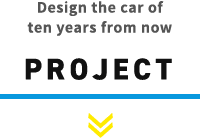Continuing from the first PBL COIL C, held last year,
this project was conducted in collaboration with Kojima Industries Corporation.
The task they provided was to "design the car of ten years from now."
Our partner university for this task was the Chinese University of Hong Kong,
which has a long history of exchange with Nanzan. Working with Hong Kong students studying Japanese,
students planned and presented an interior for the car that will be required by the society of ten years hence.

What is PBL COIL?
PBL COIL refers to the advanced-level, practical COIL-based classes in NU-COIL, Nanzan University's unique tailor-made educational program.
Through "Career Oriented International Collaboration PBL" classes, students from Nanzan University and its overseas partner universities work together to address the business and public administration issues faced by companies, organizations, and government agencies.

Kojima Industries, a Toyota-affiliated automotive interior and exterior parts manufacturer, set a challenge to "design the car of ten years from now." The goal of the project was to plan and propose a product idea from a new perspective that students can best provide. The participants split up into seven mixed groups of students from Nanzan University and the Chinese University of Hong Kong. In these groups, they used online tools to perform surveys, conduct research, coordinate views, prepare materials and make presentations.

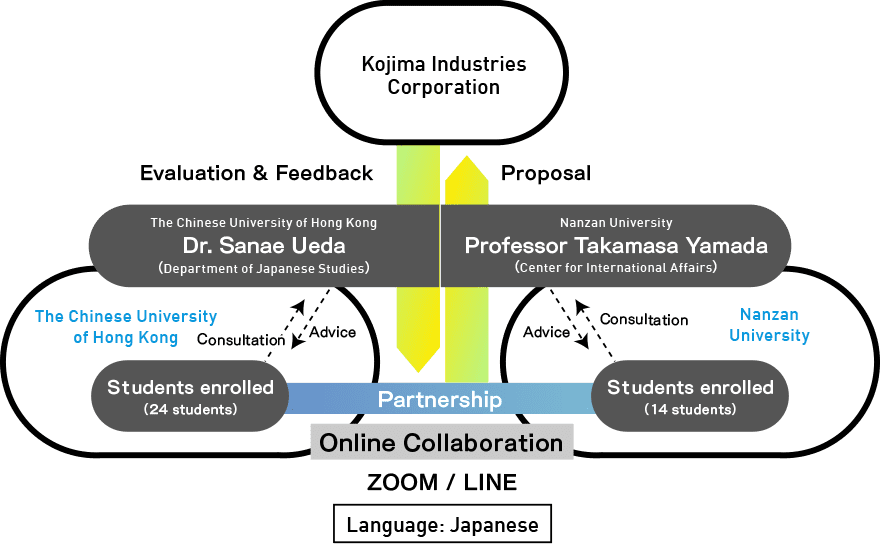

1. A Win-Win-Win Partnership
The partner university for this project was the Chinese University of Hong Kong (last year's was Arizona State University). Through our exchange programs and other initiatives, we have a long history of partnership with this university.
The students from the Chinese University of Hong Kong who participated in the project are majoring in Japanese and are highly interested in Japanese companies and businesses.
Elsewhere, the partner company, Kojima Industries, is an automotive interior and exterior parts manufacturer.
We chose Asia as the target for this project because it is an important market for the automotive industry.
The partnership with the Chinese University of Hong Kong is also an opportunity for us to become aware of the expectations of people in Hong Kong for the future of automobiles through the voices of their students.
As such, the collaboration was aimed at building a win-win-win relationship for each of the three parties.
Advantages of collaborating with a partner university in Asia
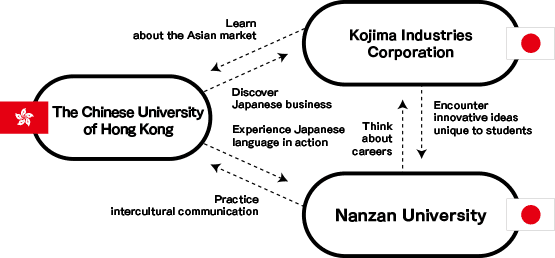

2. Provision of special lecture and task by Kojima Industries
Prior to the start of the project, there was a special lecture by Kojima Industries.
The lecture consisted of an introduction to the company, a talk on product planning, and the goal for the project provided as a task.
In particular, the "Product Planning Idea Exercise" served as the basis for the students' thinking in addressing their assignments.
The lecture started with an explanation of needs assessments, which are an essential step before starting to plan, and also discussed how to come up with ideas and the actual steps of planning.
This exercise was adapted from Kojima Industries' original training program for new employees.
For the students, it was a valuable opportunity to experience the specific product development process and expertise of a company for the first time.

Proposal to Kojima Industries and steps
Design the car of ten years from now

Steps to the presentation
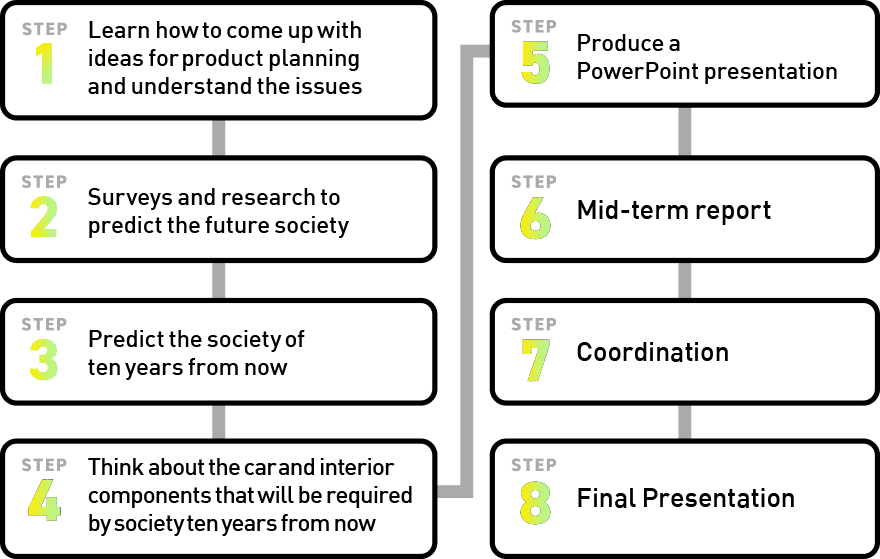
Mid-term reports and advice
In the fifth of the eight lectures, we provided an opportunity for an "interim report" before the presentations in the final session.
Each group of students presented their ongoing project to Kojima Industries.
Kojima offered frank advice, such as "Perhaps it would be more persuasive if there was more of a connection between the predicted society ten years from now and the design of the car for ten years from now," and "It would be easier to convey the concept if the planned product had a name."
By receiving direct responses, the students were able to grasp the key points important in business, and to adjust their plans and PowerPoint presentations to meet higher standards.
Aiming to make "presentations that communicate"
Because evaluation for the course is based on the quality of the final presentation, a lecture aimed at teaching "presentations that communicate your ideas effectively" was given by Takamasa Yamada, the instructor in charge of the course.

During the lecture, the students produced PowerPoint documents with their own ideas on how to clearly convey text information to the audience.

1. Intercultural communication
Improving intercultural communication skills is one of the objectives of PBL COIL.
For the students, it was a valuable opportunity to experience during their education the attitudes and perspectives that they will need when, after graduating, they go out into the world and collaborate with colleagues and customers from different cultural backgrounds.
In order to reflect on what they learned through these exchanges, the Nanzan University students submitted a "Communication Journal" once a week.
By verbalizing things they had noticed and points to improve in terms of intercultural communication, they were able to look at themselves objectively and deepen their understanding of other cultures.

Learning goals for both universities to achieve through COIL-based classes
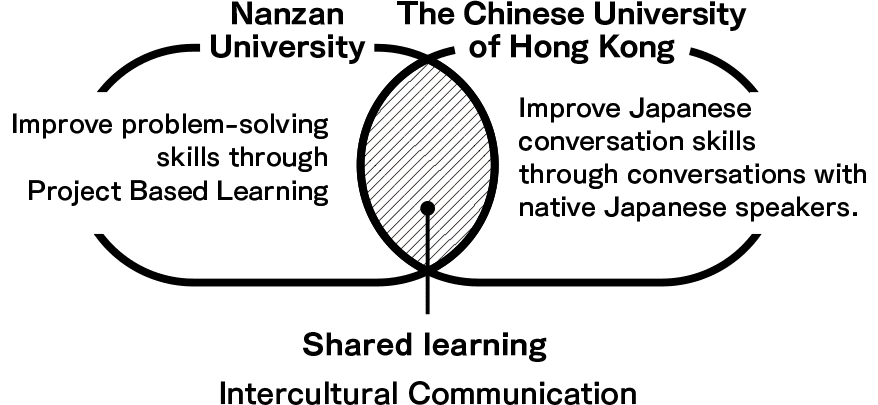
Special lecture by Prof. Sanae Ueda of the Chinese University of Hong Kong
As a review of the collaboration so far, the seventh, penultimate lecture was a special lecture given by Professor Sanae Ueda of the Chinese University of Hong Kong, titled "Problems in Intercultural Communication between Japanese and Hong Kong People."
Using specific examples, including her own experiences, Prof. Ueda, who has been teaching Japanese in Hong Kong for twenty years, lectured on two topics: (1) intercultural communication problems among advanced Japanese language learners at the Chinese University of Hong Kong, and (2) intercultural communication problems in Japanese companies in Hong Kong.
Students were able to learn from both a Hong Kong and a Japanese perspective about the communication issues that might arise when working with foreign colleagues and companies on the global stage in the future.


2.Online communication with no time difference
The time zones of Hong Kong and Japan are only an hour apart, so there is very little time difference.
This served as a driving force for exchange between the students of the two universities in this COIL-based class project.
Communication via e-mail or chat can sometimes be difficult due to time differences, but with Hong Kong, there is almost no difference, enabling speedy communication via real-time video calls.
It was also possible to hold frequent group work and discussions outside lecture hours, creating an ideal communication environment for a COIL-based class.
Student reflections on online communication

Five "synchronous" lectures held
PBL COIL is a COIL-based class that uses online tools to conduct collaborative projects and exchange views with students from universities overseas. In this PBL C project, five of the eight classes were online lectures held synchronously with the Chinese University of Hong Kong.
In the synchronous group work between the two universities, conducted outside lecture hours, students were given frequent opportunities to hold their own independent discussions, which allowed a great deal of communication to take place.

(Reference) PBL COIL C involves a total of 8 lectures and a total time of 12 hours.

1.Real-time presentations
The final lecture was a presentation session where all seven teams presented the results of their collaboration.
Four representatives from Kojima Industries, 14 students from Nanzan University, 24 students from the Chinese University of Hong Kong, one faculty member from each university, and one TA from Nanzan University made up a total of 45 people who came together online for a large-scale presentation session.
The presentations were given in real time using materials prepared in advance.
In the presentations, the students from the Chinese University of Hong Kong spoke in Japanese as confidently as the students from Nanzan University, showing no linguistic difficulty. Indeed, unless you were listening carefully, you could not tell which country they were from.
Here are some of the presentations that were given, with a time limit of 10 minutes per group.
Each group started their presentation with a "table of contents" showing the progression of the presentation.
After that, they presented their predictions of what society would look like in ten years' time, based on data from their surveys.
An emphasis was placed on evidence, and the students devised ways to express the content of their plans clearly using supporting data and illustrations.
With a view to reflecting local people's opinions, one group conducted their own survey. They aggregated the results of a survey of 126 people from both Japan and Hong Kong, producing a plan underpinned by information on actual preferences and lifestyles.
The interior, equipment, and functions of the planned car were also illustrated so as to clarify the situations where they would be used.
The relevance to future societies and lifestyles was shown visually.
Listeners found it easy to relate to the planned products through the unique product names.
By explaining the thought that went into the naming, the students were able to better convey the aim and concept of the product.
In terms of style, each group came up with their own way to make the presentation appeal to the audience. Some started with a question, some presented conclusions and then supporting data, and some even discussed issues for implementation such as costs and advertising.
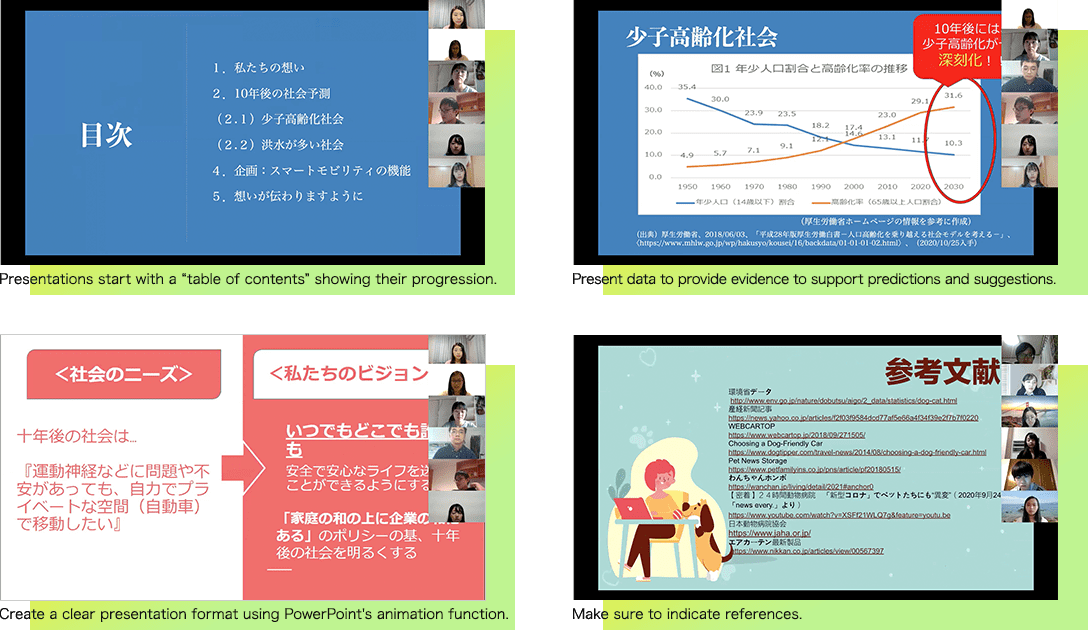
2.Evaluation and comments from Kojima Industries
After the presentations and before totaling the scores, the Kojima Industries representatives made comments based on their impressions.
All groups were commended for their well-designed, readable materials.
With respect to the students' response to the suggestions from Kojima Industries at the mid-term presentation, they said "You were able to develop the content beyond our advice in the mid-term presentation. Your applicability and flexibility will allow you to enjoy working in society."
The group that conducted their own survey was asked about its scope; as real data, it generated considerable interest.
The representatives also gave appreciative comments to a group that recovered and kept on going after the video froze in the middle of their presentation, saying "Teamwork is an ability that will be vital for your future lives. I was very impressed."
Another group used a portrait app to create introductions to the group's members on the front page of the presentation, to which the representative said that they could tell from the portraits that the discussions had gone well and imagine what the group work was like.

After the presentations, the top three groups were announced based on the evaluations of the four Kojima Industries representatives and faculty members Ms. Ueda and Mr. Yamada.
Grades were given on a 35-point scale: 15 points for ideas, 15 points for presentations, and 5 points for group work.
The differences in the overall scores obtained by the teams were small, with all groups receiving high marks; Team F, with its "slightly unrealistic idea," received first place.
A representative from Kojima Industries said, "What may seem like a bizarre idea now may become a reality in ten years. We live in an age where things that we never thought possible can become reality. I was very impressed by the content of the proposal, which surpassed my imagination."
Group A, which came in second, received a high score for expressing their product idea by creating a model, which won praise for making the presentation "very easy to understand."
Group G's proposal, which came in third, featured easy operation, innovative usability, accessibility, and warmth. This resonated with the evaluators, who said "It's an idea that I would want to buy if it existed. It satisfies the basics of presentation in terms of grabbing the audience's attention."
Toward exchange and career development for the future
This project was a valuable opportunity for students to collaborate toward a common goal alongside colleagues who have different languages and cultural backgrounds.
In particular, the exchange with students from the Chinese University of Hong Kong who were eager to work in Japan in the future created opportunities for them to consider working abroad and working for multinational companies, thereby supporting career development.
From the start of the lectures, the instructor in charge, Mr. Yamada, instructed the students that this project is about "new encounters" through collaboration and "building human relationships that transcend national borders."
The results of the post-project questionnaire showed that the participants had made an effort to get to know each other by communicating over video calls, and that they developed friendships that led to exchanges beyond the project.
From the post-project questionnaire (excerpt)
- Chatting outside project time helped develop deeper friendships and gave us motivation.
- I realized how difficult it is to assume leadership and get team members to take action.
- I felt that a shortcut to our goal was to be aware of the purpose of the meeting and proceed with the discussion.
- I learned that when communicating with people from different cultures, what is important is not linguistic fluency in conversation, but making an effort to communicate clearly and concisely.
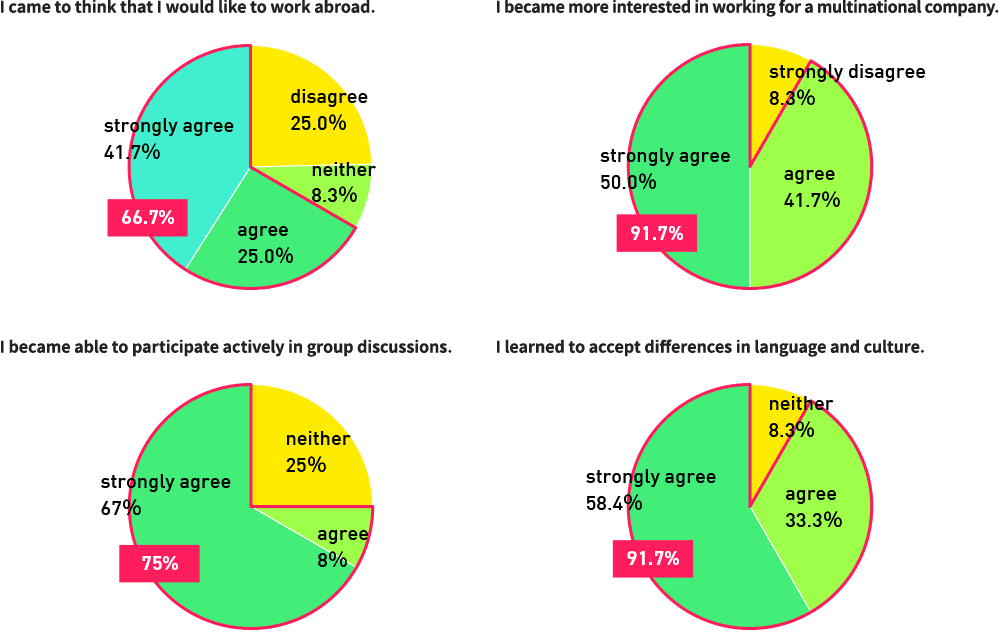


For this second consecutive year of collaboration, the location of the partner university changed from the U.S. to Hong Kong, making the collaboration even more attractive for our company as we continue to explore diversifying markets.
Because, due to the COVID-19 crisis, all interaction was conducted online, we had to be careful to eliminate problems with insufficient communication. In particular, following the midterm presentations, our opinions were summarized and sent to each group after the class, in addition to the comments we made online.
I was surprised to see how the students responded to the advice we gave on that occasion and even referred to the messages given to other teams to improve their final proposals.
Some of the information provided was very interesting, and in some cases, we followed up on the details through the instructor at a later date.
The results were at a level that we can feed back to our development department, for which we are grateful.
Koichi Ito, Chief, Human Resource Division, General Affairs and Personnel Department, Kojima Industries Corporation
My student life, which had been frustratingly incomplete due to the lack of international exchange resulting from the COVID-19 outbreak, has been provided with a new challenge by PBL COIL.
The online classes were symbolic. More than half of the computer screen was taken up by participants from the Chinese University of Hong Kong, so I really felt that I was learning together with students from a different culture.
In the team collaboration, the Hong Kong students' high level of Japanese was a saving grace.
That said, "first meeting," "different culture," and "online" all represent obstacles, so we set up an online social gathering to encourage communication. As a result, both the bonds between members and the content of our presentation developed, and we were able to deliver results.
Professor Ueda's special lecture also changed the way I perceive different cultures and encouraged me to interact with them.
The collaboration with Kojima Industries allowed us to engage with the mindset of a working member of society, and to learn about their attitude toward product development and what motivates them to work.
Ayane Niimi, junior, Program in East Asian Studies, Department of Asian Studies, Faculty of Foreign Studies, Nanzan University


This project was the first opportunity for us as students to learn about companies' product development processes and the key points for coming up with ideas.
I was able to get to know the students from the Chinese University of Hong Kong much more quickly than I had imagined, and we enjoyed talking and doing group work outside class.
The fact that the group was so diverse allowed us to draw on its characteristics to drive the discussions forward.
It took some creative approaches to tackle the assignment.
At the beginning of the week, we would always assign roles and make sure each person knew what they needed to prepare for the next time. Based on that common understanding, we took care to ensure that each person was able to fulfill their role.
I came into contact with ideas and values different from my own, and I believe that I am now able to view and think about things from a more global perspective. I have come to believe that intercultural communication is not so difficult as long as we can recognize each other's differences and develop a deeper understanding.
Hikaru Honda, sophomore, Department of Policy Studies, Faculty of Policy Studies, Nanzan University
In my opinion, the most important factor in motivating students to work on collaborative projects with companies is "authenticity," a technical term in education.
This project was not simply a hypothetical situation set up for the class: the ideas proposed by the students may provide insights for Kojima Industries when they plan their future business concept.
I believe that this kind of "authentic" attempt reinforced the students' attitude in terms of "taking on the assignment as their own," which had the benefit of dramatically enhancing each student's problem-solving ability.
The greatest achievement of this project was that students from different linguistic and cultural backgrounds were able to work together, turning their differences into the power to solve problems.
Despite the difficult situation presented by the COVID-19 pandemic, the project was sustained by the high levels of motivation shown by all the participants.
Thank you all so much for working on it through to the end.
Takamasa Yamada, Specially Appointed Instructor, Center for International Affairs, Nanzan University

Use of LMS
By having affiliated schools and Nanzan University's students and faculty exchange information in real time on the learning management system platform, it is possible to advance real-time communication that is unique to COIL classes even further.
We plan to expand the use of this LMS in the future.
Creating Relations between Basic COIL and Academic COIL
We aim to establish a step-up type of learning model in which the different categories of COIL classes--Basic COIL and Academic COIL--are prerequisites for PBL COIL.
NU-COIL Career Oriented International Collaboration
Companies and organizations that are interested in collaborations with this university through NU-COIL (e.g., PBL COIL and internships) are
welcome to contact us using the e-mail address provided below.

